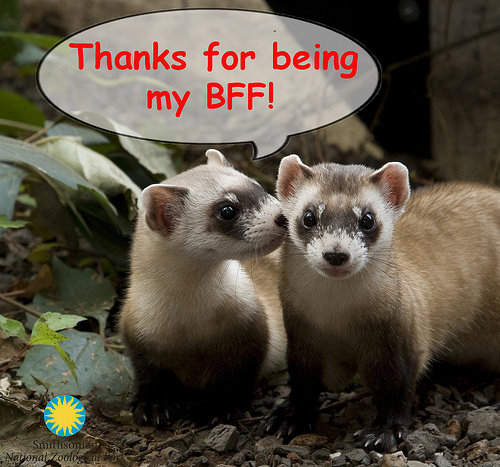Top Ten Critter Cupids from the Smithsonian's National Zoo
Experts at the Smithsonian's National Zoo have proof that romance is not only for the warm and fuzzy; friskiness is a trait all animals share-be they furry, feathered or finned. Seduction techniques abound in the animal kingdom: Zoo staff recognize when reptiles are feeling rapturous and giant pandas are peaking (hormonally speaking) and ready to procreate. The Zoo has compiled some of the most interesting mating rituals and behaviors on its website.
This Valentine's Day, web visitors can woo loved ones with a truly wild gift-bestow an honorary name upon a National Zoo critter after a sweetie, a friend or a family member. Critter Cupids include a fanciful valentine to print and present, plus the inestimable satisfaction of supporting wildlife conservation.
Did you Know?
- When a female red-sided garter snake emerges from hibernation, she releases potent pheromones that signal that she is in the mood. This attracts about 20,000 males, all of them eager to pass on their DNA. The males squirm together to form a giant mating ball around the lone female. This frenzy attracts hundreds of human tourists from around the globe to the snake's native home, Manitoba, Canada, every year.
- Cupid isn't the only one who shoots arrows to induce love. Several snail and slug species also shoot love darts (composed of calcium carbonate and protein) at their partners before mating. Although the special deliveries don't contain sperm, it's in the snail's best interest to land the sticky substance on its partner; each glob increases the chance of sperm survival when mating does occur.
- Attention female giraffes: urine good shape to attract a mate! Many male giraffes check if a female is in heat by nudging her and inducing urination. They can determine her readiness by using the Flehmen response-a technique that analyzes smells using the Jacobson's organ. Some giraffe species will go so far as tasting the urine to determine if it's time for love.
- Female kangaroos can become pregnant immediately after giving birth. A mother's pouch may become crowded with two joeys of different ages, but she can nurse both at the same time-with two different types of milk to suit each growing baby's needs!
- Microscopic mites are having incestuous sex-on our eyebrows. A Demodex female mite with no nearby males can reproduce asexually in a process called parthenogenesis. She then mates with her male offspring to produce the next generation. Luckily, they pose no known threat to our health. In fact, we may benefit from them feasting on our dead skin cells.
- Size does matter when it comes to clownfish mating habits. A female clownfish is the largest in her breeding group, followed by her mate. When she dies, her male partner will grow larger and turn into a female-a process known as sequential hermaphroditism.
- No one quite feels the pressure to perform the way a female ferret does. They produce estrogen until they mate or develop aplastic anemia, which decreases red blood cell creation. If she fails to mate after going into heat, the result could be her death.
- Ferrets are not the only animals with a killer mating practice. After a male honey bee mates with the queen of the colony, his genitals break off and remain inside her. As he tries to exit, his abdomen rips apart, and he dies.
- Bald eagles take breeding to new heights. They soar thousands of feet into the air where they lock talons and begin mating while freefalling toward the ground. They release and soar upward just before reaching the ground.
- Like Cupid, male porcupines need to have good aim when attempting to attract a female. Unlike the aforementioned slugs, male porcupines don't shoot darts, but they do aim a steady stream of urine at their intended-who could be as far as six and a half feet away. If she drenches herself in the shower, she is ready to mate.

